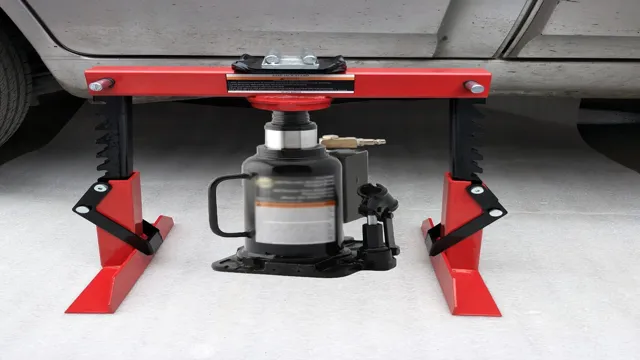Have you ever wondered what the different ratings on jack stands mean? Maybe you’re a novice mechanic or a DIY enthusiast, and you’re not quite sure what to look for. Understanding the rating system of jack stands is crucial for your safety and the success of your automotive career or project. The rating determines the maximum weight capacity the stand can hold without failing or tipping over.
A jack stand with a higher rating can support more weight, but how are these ratings determined? In this blog post, we will explore how jack stands are rated and why it matters. So, grab a cup of coffee, sit back, and let’s dive into the world of jack stands.
Understanding Jack Stand Ratings
When it comes to working on your car, safety should always be a top priority. That’s where jack stands come in, providing a reliable and secure way to support your vehicle while you work underneath it. However, not all jack stands are created equal, and understanding their ratings is crucial for ensuring that they can handle the weight of your car.
Jack stands are rated based on their weight capacity, with the rating usually displayed on the side of the stand. It’s important to always choose jack stands that are rated to handle the weight of your vehicle, as using stands with a lower weight capacity can be extremely dangerous and potentially life-threatening. So, before you get to work on your car, make sure you understand how jack stands are rated and choose ones that are up to the task.
What Is a Jack Stand Rating?
Jack Stand Rating When it comes to working on your car, a jack stand is an essential tool for safety and stability. But what is a jack stand rating, and how do you know which one to choose? The jack stand rating refers to the weight capacity that the stand can support safely, expressed in tons. It’s essential to choose a jack stand with a rating that matches or exceeds your vehicle’s weight.
For example, if your car weighs 4,000 pounds, you’ll need a jack stand with a rating of at least 2 tons. Choosing a jack stand with a lower weight capacity can be dangerous, causing the stand to collapse under the weight of the car. Always check the rating before purchasing a jack stand, and never use it to support more weight than it can handle.
Remember, safety is paramount when working on your vehicle, so always err on the side of caution by choosing a jack stand with a higher rating than you think you’ll need to ensure a secure and stable working environment.

Why Is It Important to Understand Jack Stand Ratings?
When it comes to properly maintaining a vehicle, having the right tools is essential. One important tool that every car owner should have is a jack stand. However, not all jack stands are created equal.
It is important to understand jack stand ratings before making a purchase. The weight rating of a jack stand refers to the maximum weight that it can support safely. Exceeding this weight limit can cause the jack stand to collapse, leading to serious injuries.
It is also important to consider the material and height of the jack stand, as well as any safety features it may have. Taking the time to research and acquire the right jack stand for your specific needs can ensure a safer experience when working on your vehicle. Don’t underestimate the importance of understanding jack stand ratings – it could make all the difference in keeping you and your car safe.
How to Identify Jack Stand Ratings
If you want to ensure safety when working under your car, then understanding how to identify jack stand ratings is crucial. A jack stand’s rating refers to the maximum amount of weight it can support, which is typically displayed on the stand itself or in the manufacturer’s instructions. Jack stand ratings range from 1 ton to 20 tons or more, with the highest ratings typically used for commercial vehicles like large trucks.
It’s important never to exceed a jack stand’s weight rating, as doing so can cause a catastrophic failure that could result in injury or death. Additionally, it’s essential to only use jack stands that meet or exceed the weight of the vehicle you’re working with to ensure maximum safety and stability. By adhering to weight limits and using the right equipment, you can ensure a successful and safe automotive repair or maintenance job.
Check for a Weight Capacity Rating
When it comes to using jack stands in your car maintenance routine, it’s important to pay attention to weight capacity ratings. This ensures that your jack stands can support the weight of your vehicle and provide a safe working environment for you. To identify jack stand ratings, look for a stamped label or marking on each stand.
This rating should indicate the maximum weight capacity, usually measured in tons. Make sure to match the weight capacity rating to the weight of your vehicle or the heaviest component you will be working on. Ignoring weight capacity ratings can lead to dangerous accidents, so always double-check before using your jack stands.
Remember, safety should always be your top priority when working on your car, so don’t take any shortcuts when it comes to equipment ratings.
Look for Certification Marks
When it comes to choosing the right jack stands for your vehicle, it’s important to look for certification marks to ensure that you’re getting a quality product that will keep you safe while working on your car. One of the most important things to identify is the weight rating of the jack stands – this will tell you how much weight they can support. Look for certification marks from organizations like the ANSI (American National Standards Institute) or the ASME (American Society of Mechanical Engineers) to ensure that the jack stands you’re looking at have been tested and verified to meet safety standards.
Additionally, be sure to check the construction and material of the jack stands – look for sturdy, durable materials like steel that will hold up over time. With these tips in mind, you can find the perfect jack stands for your needs and get to work on your car with confidence.
Read the Manufacturer’s Instructions
When it comes to using jack stands, safety is the top priority. One important step in ensuring the safety of your jack stands is to read the manufacturer’s instructions thoroughly. These instructions should provide you with all the necessary information you need to set up and use your jack stands properly.
One crucial aspect that you should pay close attention to is the jack stand rating. The rating indicates the maximum weight capacity that the jack stands can handle safely. To identify the rating, look for a label or sticker on the jack stands themselves or in the manufacturer’s instructions.
It should clearly state the weight capacity of the jack stands. Always make sure that the weight of your vehicle does not exceed the rated capacity of the jack stands. By following these guidelines and always reading the manufacturer’s instructions, you can ensure that you are using your jack stands safely and effectively.
Different Types of Jack Stand Ratings
When it comes to choosing the right jack stands for your vehicle, it’s important to understand the different types of jack stand ratings. The most common ratings are the weight capacity and the height range. The weight capacity of the jack stand indicates the maximum weight it can support, while the height range refers to the range of heights that the jack stand can extend to.
It’s important to choose a jack stand with a weight capacity that exceeds the weight of your vehicle, and a height range that allows you to work comfortably underneath your car. Another important consideration is the material of the jack stand. Steel is the most common material used for jack stands due to its strength and durability, but some manufacturers may use lighter materials such as aluminum for portable models.
Overall, choosing a jack stand with the right ratings for your vehicle is crucial for your own safety and the safety of those around you.
Static Weight Capacity Rating
Jack Stand Ratings If you’re planning on doing any work on your vehicle, it’s essential to have a reliable set of jack stands. But with so many different types of jack stand ratings available, it can be tough to know which ones to choose. One critical factor to consider when selecting a jack stand is the static weight capacity rating.
The static weight capacity rating refers to the amount of weight a jack stand can hold when it is not in motion. This rating is crucial because it will determine whether the jack stand is strong enough to support your vehicle while you work on it. It’s crucial to remember that this rating is per jack stand, not per pair.
So if you’re looking to buy a set of four jack stands, you’ll need to make sure that each stand is rated to hold at least half the weight of your vehicle. Different types of jack stands ratings are determined by the material and construction of the stand. For example, some jack stands are made of aluminum, while others are made of steel.
Steel jack stands tend to have a higher weight capacity, making them a better choice for larger vehicles. However, aluminum jack stands are lighter and, therefore, easier to move around. In conclusion, when shopping for jack stands, be sure to pay close attention to the static weight capacity rating.
This rating will ensure that your vehicle is secure while you work underneath it. Take into account the size and weight of your vehicle, how many jack stands you need, and the material and construction of the stands you’re considering before making a purchase.
Dynamic Weight Capacity Rating
Jack Stand Ratings When it comes to selecting the right jack stand for your vehicle, one of the most important factors to consider is the weight capacity rating. This rating indicates the maximum amount of weight that the jack stand can support safely. However, there are different types of weight capacity ratings for jack stands, and it’s important to understand them before making a purchase.
The most common type of rating is the static weight capacity, which refers to the maximum amount of weight that the jack stand can safely support when the vehicle is stationary. However, this rating doesn’t take into account the extra weight that may be put on the jack stand when the vehicle is in motion, such as when you’re changing a tire. To account for this, some jack stands come with a dynamic weight capacity rating, which takes into account the extra weight caused by movement.
This rating is typically higher than the static weight capacity rating and provides an extra level of safety when working on your vehicle. Another type of rating to consider is the lift height capacity rating, which indicates the maximum height that the jack stand can lift the vehicle. It’s important to choose a jack stand with a lift height capacity that’s suitable for your vehicle, as lifting it too high can be dangerous.
In summary, when selecting a jack stand, it’s crucial to consider the weight capacity ratings, including static and dynamic weight capacity, as well as lift height capacity. By doing so, you can ensure that you’re selecting the right jack stand to keep you and your vehicle safe while working underneath it.
Conclusion
In conclusion, rating jack stands may seem like a tedious task, but it’s essential to ensure your safety and prevent any mishaps. Whether it’s looking for a specific weight capacity, height range, or brand reputation, it’s crucial to invest in high-quality jack stands that meet your needs. So, don’t be caught without properly rated jack stands or you may find yourself in a sticky situation – and we don’t mean the sweet kind.
Remember, your safety is always the highest priority!”
FAQs
What is the weight capacity of a typical jack stand?
The weight capacity of jack stands can vary, but most range from 2-6 tons.
What is the difference between a ratchet and pin-type jack stand?
Ratchet-type jack stands have a mechanism for adjusting the height, while pin-type jack stands have fixed height positions.
Can I use jack stands on an uneven surface?
No, it is not recommended to use jack stands on an uneven surface as it can cause them to tip over.
How many jack stands do I need to support my vehicle?
It is recommended to use at least two jack stands to support a vehicle safely.
Are all jack stands compatible with all types of vehicles?
No, it is important to check the weight capacity and height range of the jack stands to ensure they are suitable for your specific vehicle.
How do I properly position jack stands under my vehicle?
Place the jack stands on a flat surface, slide them under the appropriate jacking point on the vehicle, and adjust to the correct height before lowering the vehicle onto the jack stands.
What safety precautions should I take when using jack stands?
Always use jack stands on a level surface, ensure they are properly positioned, and never exceed the weight capacity. It is also important to chock the wheels and never work under a vehicle supported only by a jack.






